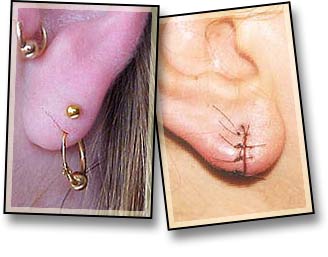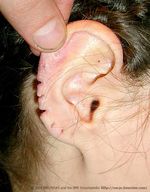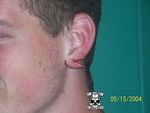Torn Lobe
If earlobe piercings (and other piercings) are done using jewelry of an inadequate gauge (anything under 14ga usually), it takes remarkably little pressure to tear the piercing right through the flesh of the ear, either tearing the piercing out entirely, or converting the small hole to a long slit — much like a wire cheese-cutter.
By using larger gauge jewelry this risk can be all but eliminated (larger gauge piercings can break as well, but this is due to piercing thinning rather than a "cutting" effect).

A torn lobe usually requires stitches. If these are not applied shortly after the injury is sustained, the lobe can sustain noticeable damage (see the two pictures below on the right — the far right photo shows an ear 25 years after the original injury was sustained).
While earlobes most commonly experience this type of injury, nipple piercings are also very easy to damage in this way.
History
Use of the term "cheese-cutter" in this context was first used (as far as we know) by Elayne Angel at Gauntlet, Los Angeles in the 1980's.




